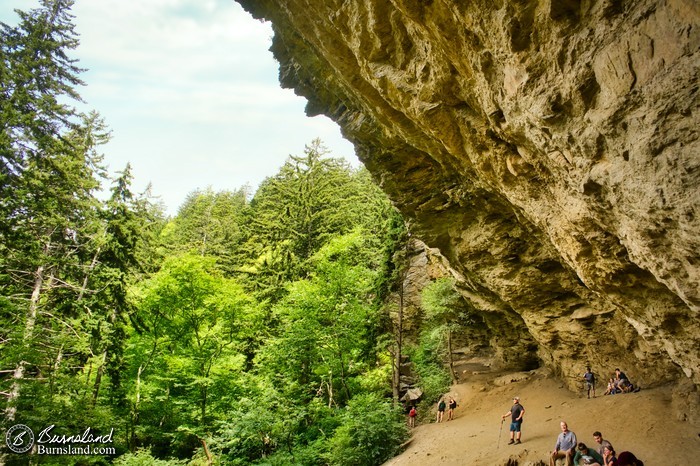The Alum Cave Trail is one of the most well-known hikes in the Great Smoky Mountains National Park, offering a mix of natural beauty, history, and adventure. Starting from Newfound Gap Road, the trail quickly immerses hikers in old-growth forest, follows bubbling streams, and winds its way toward some of the most recognizable landmarks in the park.
What makes this hike so popular is its variety. In just over two miles, you’ll pass through the stone staircase of Arch Rock, climb toward the panoramic views of Inspiration Point, and finally stand beneath the soaring Alum Cave Bluffs, a massive concave cliff nearly 80 feet high. Many hikers stop at the bluffs, but the trail also continues to Mount LeConte, one of the tallest peaks in the Smokies.
Alum Cave isn’t just about scenery—it’s also layered with history. In the 1800s, the area was mined for alum and Epsom salts, and during the Civil War it became a source of saltpeter for gunpowder. Today, those same bluffs serve as a natural rest point for thousands of visitors each year.
If you’re planning your trip, you can click here for a detailed mile-by-mile trail breakdown, or click here for the official National Park Service guide with current conditions. Gatlinburg’s tourism board also shares helpful planning tips—click here—and Pigeon Forge explains why Alum Cave is considered an iconic hike in the Smoky Mountains. For hikers looking to continue on to LeConte Lodge, click here for a guide to extending the hike all the way to Mount LeConte.
Alum Cave Trail: History, Geology, and Hiking Experience
When most people hear the name Alum Cave, they picture a cavern. In reality, it’s not a cave at all but a massive concave bluff carved into the side of Mount LeConte. Towering about 80 feet high and stretching more than 500 feet across, this natural amphitheater was formed over millions of years as water, wind, and shifting rock slowly eroded the softer layers of the Anakeesta Formation. Today, it’s one of the most dramatic natural features along the Alum Cave Trail, drawing thousands of hikers each year who want to rest beneath its sheer rock overhang and soak in panoramic views of the Smokies. To see a full trail overview, click here.
A Mining Hub in the 1800s
The bluffs weren’t always just a hiker’s destination. In the mid-1800s, Alum Cave was at the heart of a bustling mining operation. Locals discovered deposits of alum, Epsom salts, and saltpeter in the rock, each with valuable uses. Alum was prized for tanning leather and dyeing cloth, while Epsom salts were sold as a medicinal remedy. Most importantly, saltpeter became a critical ingredient in the production of gunpowder. During the Civil War, the Confederate Army relied heavily on minerals extracted from Alum Cave, turning this scenic bluff into an industrial supply point. You can read more about its Civil War role here.
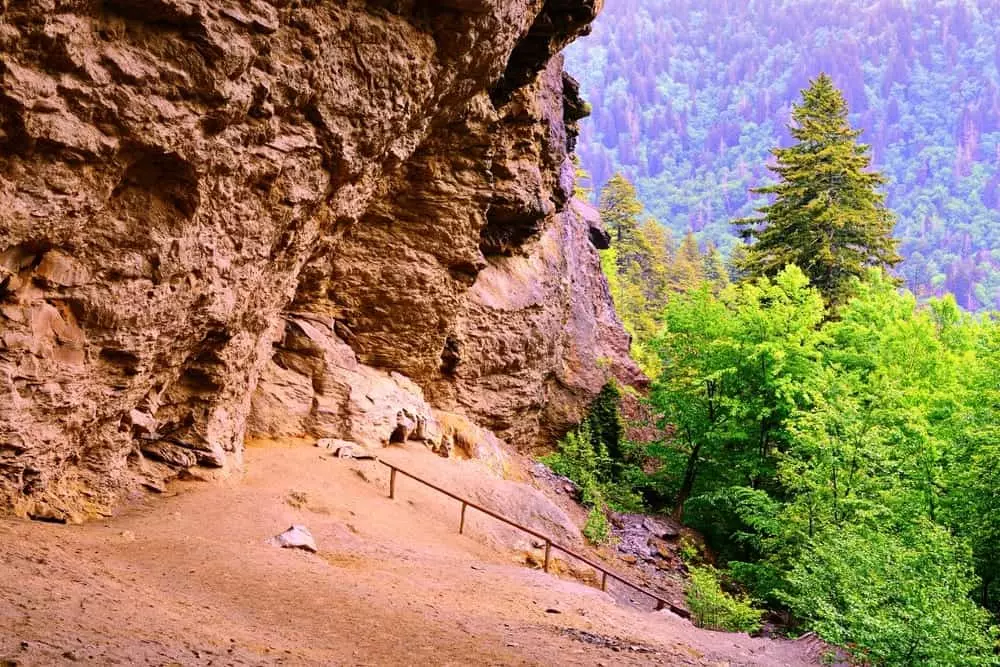
Hiking to the Bluffs
Today, the mining is long gone, but the trail to Alum Cave remains one of the most traveled paths in the Smokies. The hike to the bluffs is about 2.3 miles from the trailhead and is considered moderately strenuous, with an elevation gain of roughly 1,200 feet. Along the way, hikers pass through old-growth forest, cross log bridges over rushing streams, and navigate landmarks like Arch Rock, where stone steps carry you through a naturally formed archway carved from solid rock. Many hikers stop at the bluff itself, which offers sweeping views and a natural shelter from sun or rain. For a breakdown of key trail highlights, click here.
Alum Cave and Mount LeConte
For those looking for more than a half-day hike, Alum Cave is just the halfway point. Beyond the bluffs, the trail climbs steadily toward the summit of Mount LeConte, the third-highest peak in the Great Smoky Mountains National Park. Continuing the trek adds another 3 miles, bringing the total to 5.5 miles each way, but the reward is unmatched: breathtaking views from the summit and the chance to stay overnight at the rustic but legendary LeConte Lodge. Hikers who make it up often describe the journey as one of the most iconic experiences in the park. To plan a full hike up LeConte via Alum Cave, click here.
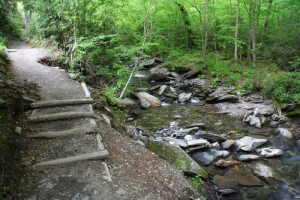
Why the Bluffs Matter
What makes Alum Cave so special is the way it combines geology, history, and modern adventure. The rock walls tell the story of ancient natural forces, while the remnants of mining recall a chapter of human industry that helped shape the region’s past. Today, standing beneath the massive overhang, hikers can look out across the Smoky Mountains and reflect on both the beauty and the legacy of this place. For another perspective on why Alum Cave is considered an “iconic trail,” click here.
Getting There & Parking at Alum Cave Trailhead
Directions
The Alum Cave Trailhead lies along Newfound Gap Road (US‑441) between Sugarlands Visitor Center near Gatlinburg and Newfound Gap.
From Gatlinburg, drive 8.6–8.7 miles south on US‑441. Look for a marked trailhead on the left. There are two parking lots, one directly after the other, where the trail begins between them. The lower end of those lots has public restrooms.
- From Cherokee (North Carolina), head north on Newfound Gap Road. The lots will appear about 23 miles from the NC entrance, around 5 miles beyond Newfound Gap overlook, on the right side.
Parking Tag Requirement
Great Smoky Mountains National Park requires a parking tag—daily ($5), weekly ($15), or annual ($40)—for any overnight or daytime parking beyond 15 minutes. This tag is not an entrance pass, and must display your license plate. Acceptable tag forms include physical printed tags placed on the dashboard (digital versions are not allowed).
Tags are available online (Recreation.gov) or in person at locations like Sugarlands Visitor Center, Gatlinburg Welcome Center, or at kiosks at various park locations. Plan ahead: in‑person tags expire at midnight.
Note that tags do not guarantee parking. Trailhead lots fill up early—on busy weekends they can be full by 8–9 AM.
Parking Capacity & Tips
There are two main lots, but overall space is limited and fills fast. Overflow parking along the road is not officially allowed but commonly used when lots are full. One hiker recommended arriving at dawn, especially on weekends, to secure a spot or risk being forced to walk from farther down the road.
Once parked, the trailhead has a pit toilet. Beyond that, restrooms are absent until reaching Mount LeConte Lodge.
Alum Cave Trail Overview
Distance and Difficulty
The trail stretches 5.5 miles one way (11 miles round trip) to the summit of Mount LeConte. The first 2.3 miles take you to the Alum Cave Bluffs, a popular turnaround point for those not continuing to the summit. According to the guide, the hike is rated moderate to strenuous, with an elevation gain of roughly 2,700 feet, making it manageable for fit beginners but still challenging enough for seasoned hikers. For a detailed breakdown of elevation and distance, click here.

Trail Features
Hiking in the Smokys highlights some of the key landmarks along the way. You’ll pass Arch Rock, a natural rock arch that hikers climb through using a staircase of stone steps; Inspiration Point, which offers sweeping vistas of the valley; and the Eye of the Needle, a hole in the rock near Peregrine Peak where rare birds of prey are sometimes spotted. Each of these features is carefully explained on their site, so if you want a landmark-by-landmark breakdown, click here.

Best Seasons to Hike
The website also notes that Alum Cave is spectacular in every season, but each brings its own character. Spring and summer fill the trail with wildflowers and greenery. Fall transforms the mountainside into a tapestry of fall colors, while winter can create a wonderland of ice formations on the bluffs. Because of steep climbs and icy sections, winter hikers are advised to bring traction devices like microspikes. To see what conditions are like season by season, click here.
Things to Do on the Alum Cave Trail
The Alum Cave Trail is more than a walk in the park—it’s a journey through geological wonder, history, and high-altitude beauty. Here are the top things to do while hiking the trail, packed with detail and context to bring each moment alive.

1. Marvel at Arch Rock
Roughly 1.4 miles into the trail, hikers cross a log footbridge over Alum Cave Creek and arrive at Arch Rock, a natural stone arch carved by centuries of freeze-thaw erosion. A narrow path leads through the arch via stone steps and a cable railing—making it both dramatic and accessible. It’s a perfect early spot for a photo or pause

2. Breathe Deep from Inspiration Point
About 2 miles in, Inspiration Point offers sweeping views from a heath bald. On clear days, you’ll see ridges like Chimney Tops, Sugarland Mountain, and Anakeesta Ridge, as well as the distinctive “Eye of the Needle”—a hole in a ridge that catches the light just right. It’s a great spot to rest, reflect, and take in the Smoky Mountain layers.

3. Spot the Eye of the Needle
Adjacent to Inspiration Point, you might notice the Eye of the Needle—a naturally formed window through rock on Little Duck Hawk Ridge. It makes for a unique photo opportunity and highlights the dynamic terrain above.
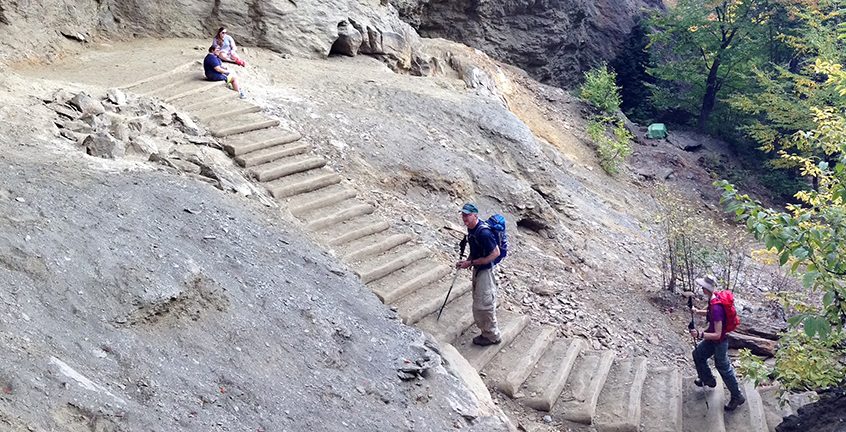
4. Navigate the Iconic Log Steps
Shortly before reaching the bluffs, hikers climb impressive log steps built into the mountainside. These rustic steps—compact logs layered into the trail—offer both charm and support on the steepest ascent.
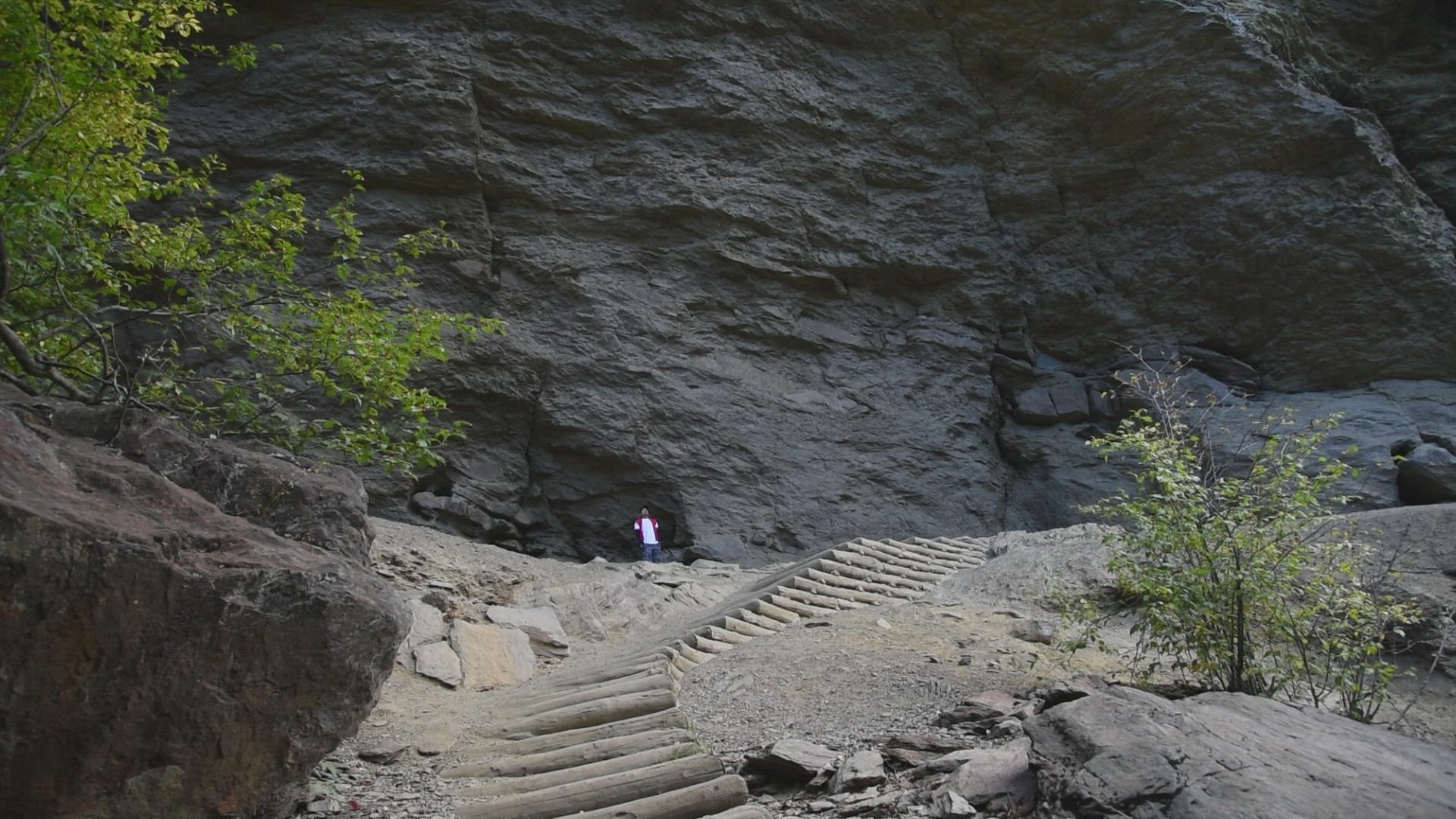
5. Stand Beneath the Alum Cave Bluffs
At about 2.2 miles from the trailhead, you arrive at the famous Alum Cave Bluffs—a massive sandstone overhang rising nearly 80 feet. The bluff provides natural shelter and panoramic views, making it a favorite turnaround spot. Listen for the faint mineral scent in the air and watch for icicles hanging in winter.
6. Continue to Mount LeConte (for the adventurous)
This midpoint is only the beginning. If you’re up for a challenge, continue on toward Mount LeConte, reaching the summit via another 3 miles and ascending over 2,700 feet in elevation. From the top, explore overlooks like Cliff Tops and Myrtle Point, or stay overnight at LeConte Lodge, the rustic inn tucked into the spruce-fir forest.
| Thing to Do | Description |
|---|---|
| Arch Rock | Walk through a dramatic natural stone arch with built-in stairs |
| Inspiration Point | A scenic overlook offering ridge views and fresh mountain air |
| Eye of the Needle | A mountain “window”—a distinct rocky hole—visible from the overlook |
| Log Steps | Rustic log steps built into the trail leading to the bluffs |
| Alum Cave Bluffs | Massive overhang offering shelter, views, and historical vibration |
| Summit LeConte | Extend to the summit for overnighting at LeConte Lodge and summit views |
Final Thoughts
The Alum Cave Trail is one of those rare hikes in the Smokies that balances accessibility with awe. In just a few miles, you’ll encounter old-growth forests, historic landmarks, sweeping overlooks, and the sheer drama of the Alum Cave Bluffs themselves. Whether you stop at the bluffs or push onward to Mount LeConte, the trail delivers a mix of history, geology, and Smoky Mountain beauty that keeps it on every hiker’s must-do list.
When planning your trip, timing matters.
Spring (March–May): Wildflowers bloom along the lower sections of the trail, and streams run strong, creating a lush start to the hike. Cooler temperatures make climbing more comfortable.
Summer (June–August): Expect crowds and humidity, but also the fullest forest canopy and shaded paths. It’s the most popular time of year, so start early to secure parking.
Fall (September–November): Perhaps the best season—brilliant foliage lights up Inspiration Point and the ridgelines around the bluffs. Cooler air makes the climb more manageable.
Winter (December–February): A quiet, less crowded experience, though the trail can be icy. Alum Cave Bluffs often form spectacular icicles, making it especially photogenic if you’re prepared for the conditions.
For most visitors, the sweet spot is early fall—late September through October—when the weather is crisp, the crowds are lighter than midsummer, and the views explode with autumn color. Early morning starts are also recommended year-round, both for parking availability and to experience the trail before peak visitor hours.
In the end, Alum Cave offers more than just a hike. It’s a glimpse into the Smokies’ layered story of natural forces, human history, and breathtaking scenery. Whether you’re after a family-friendly day hike or a demanding summit trip, Alum Cave is a trail that rewards every step.
Where to Stay

If you’re planning a trip to Alum Cave Bluffs and need a nearby place to stay, our tiny homes at Sojourn Lodging are just a short drive away. We’re located in Sevierville, near the base of the Smoky Mountains, making it easy to visit the caverns and still enjoy a quiet, comfortable place to unwind afterward.
Our stays are designed to be simple but elevated – think private decks, cozy sleeping spaces, kitchenettes, Wi-Fi, and streaming-ready TVs. Every unit has been thoughtfully laid out to give guests space to relax, reset, and reconnect with nature or each other. Whether you’re here for a solo trip, a weekend getaway, or a group retreat, we have options that fit your plans.
We offer:
- Pet-friendly units
- Self check-in and private entry
- On-site parking
- Tiny homes for couples, families, and group bookings
- Peaceful surroundings that still keep you close to all the action in Pigeon Forge and Gatlinburg
Want a closer look? Click here to explore our tiny homes or read more about what it’s like to stay at Sojourn.



